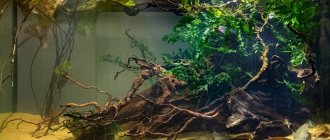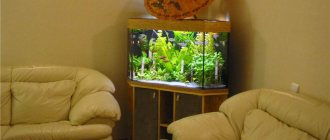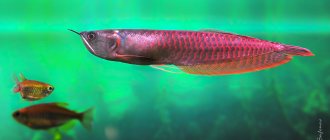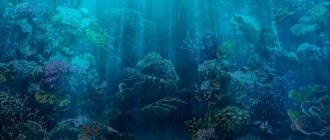A fabulous underwater kingdom... The distant corners of an aquarium that is not yours, buried in darkness, seem so alluring! Sometimes what you see is so mesmerizing that you want to do something similar in your own home. By what means can this be achieved, how to make the underwater landscape attractive and rich? How to spur your imagination and not harm the inhabitants of the aquarium?
The last question is especially important. A home aquarium, like any unstable ecosystem isolated from the natural environment, is not a place for ill-conceived experiments. Any object thrown into the water can upset this fragile balance. Let me quote here the words of the famous aquarist D. Standford: “The success of an aquarist is determined by his skills in long-term planning... frivolity and negligence in solving technical issues are fraught with unforeseen expenses in the future and, what is even more unpleasant, the death of pets. But the time and money spent on planning and preparation will pay off in full, allowing you to create a beautifully designed “viable” aquarium with healthy and active inhabitants.” These words fully apply to decorating an aquarium. In addition, a conscientious aquarist is obliged, if possible, to create conditions for the fish that are close to natural. This means that solutions must meet the biological needs of fish.
Traditionally, gravel of various fractions and colors, coarse river sand, pebbles, pellets, stones, aquatic plants and, finally, driftwood (soaked wood of various tree species) are used as decorations in an aquarium. Oak bark, bamboo, and coconut shells are used in decoration. The general name for roots, snags and other fragments of trees used in the interior of an aquarium is Driftwood (literally, “drifting tree”).
Aquarium stones
In most cases, a community aquarium contains fish that come from a natural environment where rocks and stones are present in abundance. If you keep fish from rocky reservoirs, an absolute requirement is the presence of stone structures in the aquarium.
Stones, like the substrate, should not affect the chemical composition of the water - unless this is the intention of the aquarist. They should not contain minerals that may be toxic. It is also important to avoid rocks with sharp chips or protrusions that could injure fish. This is especially dangerous if the aquarium contains restless fish, which, in fright, begin to panic and rush around the entire aquarium. If stones are intended to be used as a substrate for spawning, they should at least have a smooth surface in places. If there are fish in the aquarium that usually lay eggs in crevices, it is necessary to create an imitation of them.
Purchasing stones for an aquarium
Some stores have a small selection of stones - usually calcareous and slate, with unsuitable types of slate sometimes offered. It is important to keep in mind that not all stones sold in pet stores are suitable for aquariums. It is advisable that the aquarist have an idea of natural rock types and know their names. This will give him the opportunity to collect stones himself if he wishes. Illustrated books on geology usually show images of rocks and their composition, so it is not difficult to master the necessary information about rocks. However, to avoid unwanted situations in your aquarium, when looking for rocks, you should avoid rocks containing calcium and manganese salts. Stones from the beach, polished with water, can serve as an excellent decoration for an aquarium.
Rocks used in aquariums
Gneiss
It is a very hard metamorphic rock. Often striped, the stripes are usually gray, grey-green or white, sometimes pink. Usually fine-grained. Almost neutral. Good rocks for an aquarium, suitable for any purpose.
Granite
A hard rock of volcanic origin, speckled, gray, black or white, mainly used for decorative finishing of buildings. There is also a special variety of orange color. Almost neutral and an excellent all-round aquarium material. Limestone. Sedimentary rock composed primarily of calcium carbonate. Some limestones also contain magnesium salts. Limestones range from fine-grained and hard to coarse-grained and crumbly. Usually grayish or whitish in color. May include fossils. Increases or buffers hardness and pH.
Sandstone gray
A very hard metamorphic rock, grayish in color and speckled. Almost neutral. Suitable for use in a community aquarium.
Sandstone
Sedimentary rock consisting of sand. Its composition, and therefore its effect on the chemical composition of water, is determined by the composition of the sand. Some sandstones increase water hardness and pH. There are soft and brittle sandstones; they are not suitable for use in an aquarium. Slate. A very hard metamorphic rock known for its gray color (usually dark gray) and layered structure. It can be easily split into relatively thin sheets or plates with flat edges. Some shales contain intrusions of other minerals between the layers, appearing as colored veins or layers on the side faces of the shale. Such slates are not suitable for use in an aquarium. However, clear slate, including old slate slabs, is an excellent neutral rock. (The shale chips are sharp enough to cause serious injury to unwary fish. This must be taken into account when constructing rocky structures.)
Calcareous tuff
Very rough and brittle limestone. It is popular with aquarists who keep fish that come from bodies of water with alkaline water and underwater rocks. It is porous and lightweight, and can be used to build large structures that rest on the back glass of the aquarium without being overloaded. It is absolutely useless as a substrate for spawning because its surface is too rough.
Tips for choosing stones:
• Do not collect stones in areas where there are mines or quarries where metal or mineral ores are mined. If there are quarries somewhere nearby that produce stones used in construction or for making tombstones and statues, this is a good sign, since such stones must have a uniform structure and not contain inclusions of foreign minerals that may be toxic. However, even this does not exclude their influence on water hardness and pH. Quarry workers can sometimes provide valuable information about rock types. • Avoid areas where stones may be contaminated, such as pesticides or radioactivity. • Avoid stones with metal veins or rust-colored layers, or stones containing colored crystals. However, if you see white or clear crystals or veins, it is most likely quartz and is safe. • Do not use soft or crumbly rocks (with the exception of calcareous stones in alkaline water aquariums). • Keep in mind that dull, grayish-white rocks are most likely limestone, while rocks that resemble sand in color and texture are most likely sandstone. • Look for stones with even color, evenly spaced speckles, and uniform structure. • Among water-polished stones, choose ones that have a uniform surface and no holes or cracks. • Remember that rocks that contain fossils are usually limestone. • Avoid brightly colored stones (unless you are sure they are safe) as the color may be due to some unwanted minerals. • Do not take stones from the walls and spoil the environment in any one place. If possible, ask permission to collect rocks and try not to leave any evidence of your activity. If possible, leave the rural landscape untouched. In general, the simpler the rocks are and the less interesting they are to look at, the more likely they are to be safe in terms of toxicity, although they may still affect water chemistry. This can be tested using the “acid test” discussed above in the section on primer materials.
And one last note: you shouldn’t give up decorating your aquarium with stones just because acquiring them requires some effort. Once you have suitable and safe stones, they will never break down or wear out completely and will become a long-term asset to your hobby.
If you do not feel confident enough in your abilities and knowledge to collect and check natural stones yourself, it is better to contact pet stores. Some stores sell artificial stones, including so-called lava, which is not real volcanic lava at all. Some artificial stones are remarkably similar to real ones, although their range of sizes and shapes is quite limited and they are quite expensive. But they, like the real ones, will serve you all your life.
Preparing stones for use
All stones should be washed thoroughly in water (without soap or detergents) to remove dirt, moss and lichen. Particular attention should be paid to cracks and holes where dirt, insects, etc. may be located. It is better to immerse stones collected in natural bodies of water in boiling water to destroy all aquatic living creatures that could settle on them. These creatures may include pests, as well as pathogens and parasites. Instead of boiling, the stones can be dried for one to two weeks.
Aquarium shells
Shells should not be considered a suitable addition to a community aquarium as they are composed of calcium carbonate and can affect water hardness and pH. However, some fish species (mainly the shell-dwelling cichlids of Lake Tanganyika) certainly require spiral shells for shelter and spawning sites. To do this, they usually take the shells of French edible snails, Escargots, which can be purchased in gourmet food stores or ordered in French restaurants. They are ideal for most fish species. Sinks sold as interior decoration are also suitable provided they are not painted or varnished. Shells from the sea coast must first be sterilized by boiling, and then all accessible surfaces must be scrubbed clean. Those shells that have been empty for some time are well polished with water and are preferable to those that may still contain the remains of dead shellfish.
Obviously, whatever shells you choose, they first need to be the right size to accommodate the fish that need them.
We think about the design in advance
The decoration material is selected depending on the expected water hardness in your future aquarium. If you are going to keep cichlids from African rift lakes, then it is logical to choose soil with a high content of calcium salts (coral chips, coral sand), and from stones - tuff and sandstone. They are a means of increasing water hardness and alkalizing it. If your aquarium contains species that prefer soft water, then the listed decorative elements are not suitable for you. Tap water sometimes has a hardness higher than 8°dH. Such water is not suitable for creating soft-water biosystems, and it needs correction. Very often, soaked wood helps with this, which we will discuss below. Driftwood placed in an aquarium does not shift the pH by much, but sometimes this is enough.
Tree fragments are popular in the aquarium hobby for several reasons: firstly, in addition to the benefits mentioned for fish, they look natural in the underwater landscape you create. Secondly, they are lighter than stones, and if a wooden structure collapses, there is less risk for pets and the glass walls of the aquarium. Thirdly, they not only help create shelters for fish, but also hide elements of the technical equipment of the aquarium. Fourthly, many aquarists keep catfish from the Loricariidae family, and softened wood is the best menu for these fish. Fifthly, various aquarium plants (anubias, Thai fern), which require a substrate to secure their roots, cling well to snags. Java moss can also be added to driftwood.
Driftwood for an aquarium
Driftwood can be a wonderful decoration for an aquarium. In addition, wood is a natural form of shelter in natural fish habitats. However, this does not mean that any piece of wood found in the wild is suitable for an aquarium, even if you found it in a river or stream. An aquarium does not have the advantage of constantly renewing water, which dissolves and washes away all the toxic organic substances released by decaying wood. In an aquarium, such substances can quickly accumulate and reach critical concentrations. In addition, wood contains natural acids that can cause a noticeable decrease in pH value. Typically, only certain, fairly safe types of wood are used - bog oak, balsa wood, bamboo and coconut shells. Since these types of wood can also release tannin and other substances into the aquarium water, they require careful selection and preparation before use (see below). Usually they are placed in the aquarium only if their oxidizing effect is not capable of causing harm to the fish or if they are coated with varnish to prevent the leakage of harmful substances. Placing unvarnished wood in an aquarium can also cause the water to be tea-colored. However, this is quite natural for fish that live in nature in streams flowing through tropical rainforests. However, some aquarists absolutely do not like this. You can get rid of tea color by passing water through a carbon filter.
Purchasing wooden elements for an aquarium
Bog oak
As its name suggests, it is found in swamps and swamps. It represents the remains of ancient trees, preserved for centuries by natural preservatives such as tannins. Suitable sources of bog oak are usually strictly protected by companies with "mining rights", so bog oak is usually purchased in stores rather than collected from the wild. It is expensive, but it lasts for many years and is a very attractive natural decorative element.
Cork tree
This is the bark of the cork oak Quercus suber. It can be purchased at some pet stores, as well as flower and gardening stores. Its independent collection is usually difficult.
Bamboo
Can be purchased at flower and gardening stores. Make sure it has not been treated with preservatives or other chemicals. In gardening, bamboo sticks are commonly used as supports for peas or beans and other garden plants. Use only new poles because old ones may be contaminated with pesticides or fertilizers.
Snag
These are submerged fragments of trees and can be collected on the shore of the sea or a freshwater body of water. Only completely bleached (due to exposure to the elements) and hard pieces of wood should be collected. Immersion in seawater usually removes most of the tannins from the wood. However, driftwood may contain residual salt that is undesirable in a freshwater aquarium.
Mangrove
Pieces of tree roots in an aquarium look very attractive. These exotic trees grow in tropical forests along river banks. Keeping the roots in water provides natural protection for the tree from rotting, making them ideal for decorating aquariums.
Artificial driftwood
For aquariums are also sold in pet stores. Some of them are amazingly realistic and literally indistinguishable from real wood. They are expensive, but like stones, they will last you a lifetime.
Preparing wood for use in an aquarium
All wooden objects should be soaked (soaking should last several weeks or months, not days) to remove all stains. This process can be accelerated by boiling or soaking in hot water, which must be changed several times. Softwood should be scrubbed and scraped as much as possible.
In winter, coconut shells can be hung in the garden as a bird feeder and left there all summer, then by autumn they will be perfectly cleaned due to exposure to atmospheric phenomena.
The problem of harmful substances can be quickly solved by coating the wood with varnish. In this case, the varnish must be waterproof and non-toxic. However, in most cases wood has cracks and crevices that cannot be effectively sealed, so the slower method is still more reliable. In addition, some fish (for example, catfish and cichlids from the genus Huaru) have a habit of scratching and gnawing wood and can be poisoned by varnish. This can happen even if the varnish is nominally safe, since the concept of varnish safety does not include cases of using it for food, etc.
What can be used to decorate an aquarium?
Snag is a waste product from peat mining, mainly root wood that has lain in the swamp for up to a thousand years. Once upon a time, snag was the only type of wood that was used in aquarium keeping. Dried snag is light and difficult to absorb water when soaked.
Aquarists consider it a success to find the root part of a willow that has lain in water for a long time; it sinks well and, most likely, will not be subject to decomposition, and its roots are intricately intertwined. The best place to collect driftwood is the banks of natural reservoirs. It is desirable that the reservoir be flowing and not polluted by sewage.
Any tree chosen does not have to be "live". Wood containing “live” juices will require more serious and lengthy preparation. It is not recommended to take a tree with rotten wood and rotten roots.
However, if the driftwood you like has softened in places, the rotten places can simply be removed. It is advisable to clean off the bark, however, many aquarists leave it for the delight of chain mailers. Wood that has been worn away by insects is especially valuable, because the fact that it has been infested with larvae and bugs indicates that it is “edible” for catfish as well. Chain-mailed catfish prefer to scrape with their suckers not mangroves and mopani (they are quite tough), but apple, pear, nut or willow trees. In general, aquarists use black alder, beech, maple, elm, juniper, ash, willow, grapevine, acacia, and olive tree. A controversial issue is the use of eucalyptus, since, despite its pleasant color and intricate curves, it contains resin and essential oils.
For the same reason, coniferous and resinous species should not be used. You cannot immerse the bark of the Portuguese cork oak tree in the aquarium; it releases a complex of chemicals into the water, including humic acids in high concentrations. The water turns dark brown. (Although there is experience in maintaining both eucalyptus and spruce without visible damage to the fish population.)
Other aquarium items
Objects such as clay ceramic pots for plants or saucer trays, as well as pipes, are often used as caves for aquariums. Fish willingly occupy such “caves,” preferring them to more natural structures built of stones. If such items are too unsightly, they can be hidden between stones or among plants. You can lay the flower pot on its side or first break off a piece from the rim (this will be the entrance), and then turn it upside down and place it in the aquarium. Drainage trays or saucers are also usually used upside down, after making an inlet hole in the rim. Ceramic products must be new, otherwise particles of pesticides or fertilizers may enter the water and remain in the porous clay even after thorough washing.
Plastic pots should not be used as the plastic they are made from can be toxic. Plastic pipes intended for drinking water supply are suitable for use in an aquarium, but waste water pipes should not be used.











